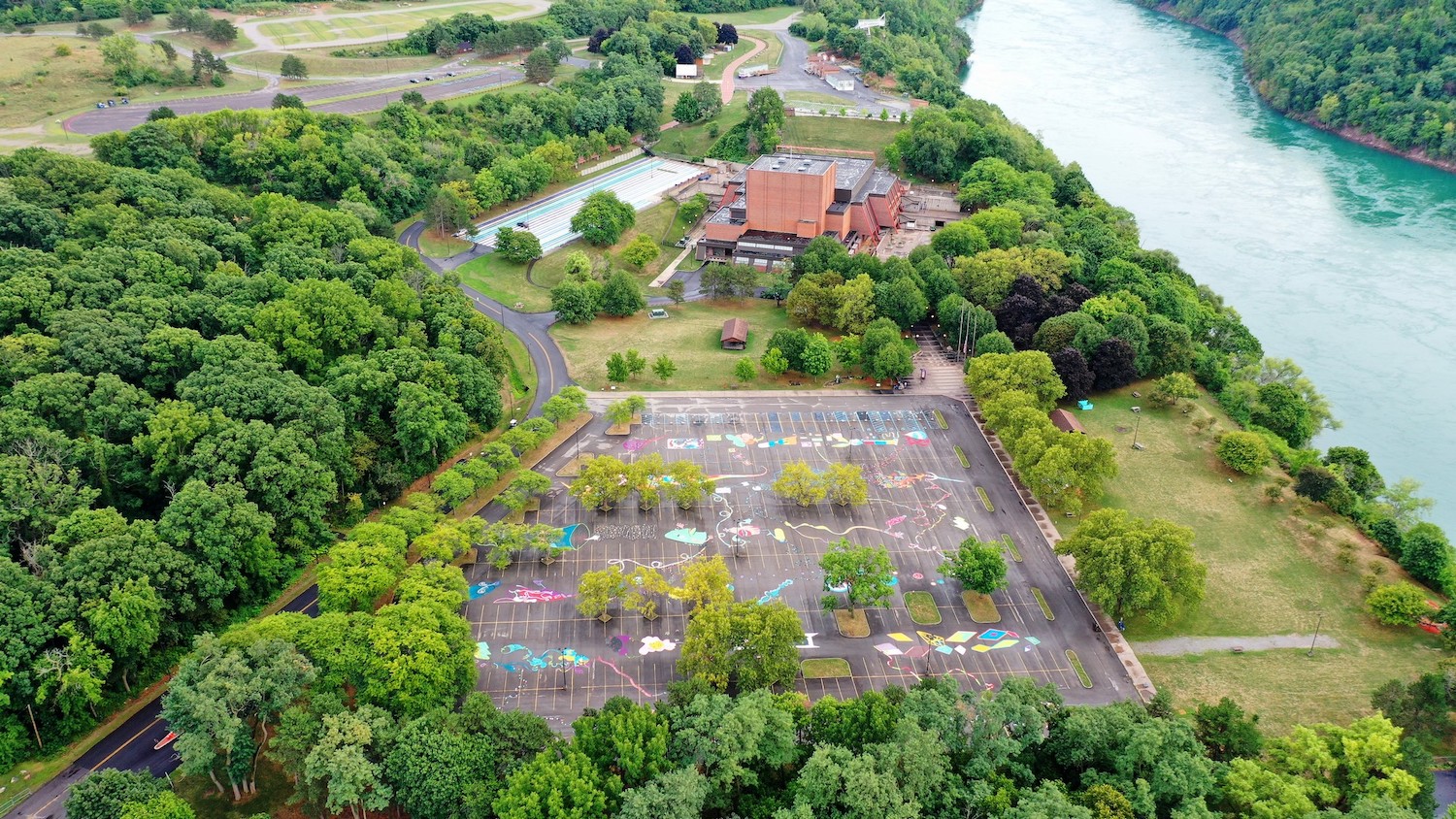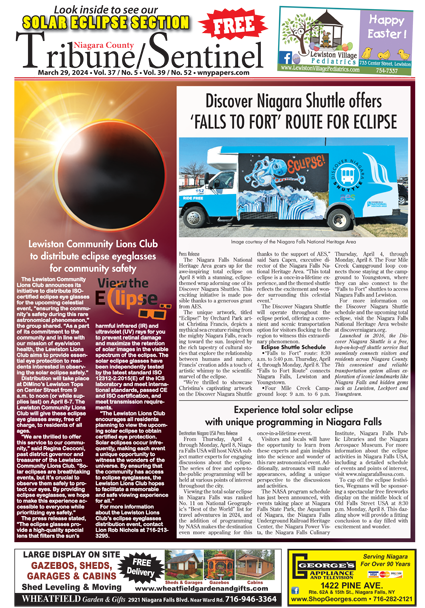Featured News - Current News - Archived News - News Categories
By Michael DePietro
As usual, The Town of Lewiston’s seal was prominently featured on the wall directly behind Town Board members during Monday’s meeting. At the bottom of the seal, of course, the year 1823 is listed as the inaugural date of the town’s formation.
Turns out, members of the Historical Association of Lewiston (HAL) believe that date is wrong.
Marjorie Louise Maggard, secretary of HAL and treasurer of the Bicentennial Committee for the Village and Town of Lewiston, presented board members a scanned copy of Chapter XV from the Book of the Laws of New York of 1818 located in Niagara County, showing the town is five years older than the insignia would suggest,
Passed on Feb. 27, 1818, the chapter details “an act for dividing the town of Cambria in the County of Niagara.” It then goes on to detail the portion of Cambria that would “hereby (be) erected into a separate town by the name of Lewiston.”
Maggard, a member of the Niagara County Historians, said she and Bicentennial Committee Secretary Donna Garfinkel, who’s also town clerk/tax collector, have been working to find out where 1823 came from in preparation for the town’s bicentennial celebration slated for 2022.
Councilman Bill Geiben noted that, while many documents and signs around the area cite the town’s formation as 1818, the common belief is that there was an official reason for the 1823 date featured on the seal.
“We’ve been sitting here under 1823 wondering if there was an official happening at that date,” Geiben said, pointing up at the seal. “And that has been proven not to be correct.”
“It seems pretty conclusive that 1818 is the date,” Councilman John Jacoby said of discussions with HAL. “I think from this point forward, I think we should move forward, in both the bicentennial and just our historical preservation, recognizing that 1818 is the date.”
Maggard was seeking the board’s permission to form a committee to redo the town seal. For now, the board recommended the Bicentennial Commission meet as scheduled this week and return before the board at a session on Monday, July 8, to determine the fate of the town seal.
The town still plans to go ahead with the 1822 bicentennial celebration in order to coincide with the Village of Lewiston’s 200-year anniversary. That municipality, by all indications, formed in 1822.
Riverfront Park Update
Town of Lewiston Engineer Robert Lannon of GHD Consulting provided a brief update on the testing and sampling conducted at the site of the proposed Lower River Road Town Park.
“Results of the fourth round of sampling showed results that were consistent with what we had found in prior rounds,” he said. “Really nothing much has changed based on those results.”
Lannon said the board received a letter in response to last month’s Riverfront Park Site Characterization Report in which the DEC said the site doesn’t qualify for the New York State Superfund Registry.
Supervisor Steve Broderick said the DEC’s letter would soon be available on the town’s website.
GHD environmental scientist Kathy Galente was on hand to field questions from the board.
Jacoby asked if the analysis showed any signs of migration of the hazardous materials found there. Galente said no. Jacoby then asked her, “Based, not only scientifically, but on your own experience and your own feeling, would you have any reservations or qualms about the park there?”
Galente replied she did not.
GHD is set to have an audience with the Environmental Commission at 7 p.m. July 8 to answer any questions or concerns the Environmental Commission has.
Water Bill Software
During Broderick’s liaison report, the board approved the purchase of new billing software from Edmund’s Govtech to address some of the recurring issues many residents have experienced with their water bills.
“Anyone who comes to meetings regularly knows our frustrations with the water department’s billing.” Broderick said.
He noted that, last week, he went to Buffalo to tour the post office facilities where the town’s water bills come through.
“(The bills have) a small perforation and, when it would go through the machine – four times it goes through the machine – it started ripping. We’ve had whole neighborhoods not get their water bill.” Broderick said.
He explained the funds for the purchase will be paid “indirectly” by the town.
“(Three years ago), we initiated a $100 administration fee on (delinquent) water bills. … For the three years that that’s been on the books, we brought in $150,000. … We’re going to indirectly justify the (money for) water bill software … from that payment revenue,” Broderick said.
The total amount approved for payment Monday was roughly $32,000, solely for the Water Department. However, Edmund’s offered a total quote of $66,430 to eventually replace the billing software in the budget/finance, and payroll departments, as well. The board will go forward with that at a later date, with money for the remaining amount of the quote to appear in the 2020 budget
Broderick said the new software will allow residents to view their bill online, enroll in auto-payment, receive email notifications, and to opt out of a paper bill.
Jacoby praised the purchase. He said, “This will put us in a place where we’re less likely to have someone in front of us who legitimately didn’t receive a bill and they’re paying late fees.”
Broderick also noted steps were made to ensure those who opt-out of the online system are more likely to receive their water bill, as well. Paper bills will now be made from a thicker stock of paper.
Green Space Project
Parks Superintendent Mike Dashineau addressed a number of rumors regarding the post-cleanup future of the green spaces along Michelle Court.
“I’ve heard people say we’re putting in a dog park back there; we’re putting a bike trail back there; all kinds of stuff. Just so everybody is aware, we don’t have room for any of that back there,” Dashineau said. “Most of this is very wet property that is meant to be green. We would have to change the definition of green space to active parkland.”
Dashineau said no future plans for the sight will be made until after cleanup.
Budget Moves
Finance/Budget Director Jacqueline Agnello presented two revisions for the 2019 budget. The first was a request to move $3,000 to the treatment disposal of gasoline diesel fuel budget in the SS1 sewer department from the treatment disposal contractual budget, also in the SS1 fund.
The second was to sign the necessary paperwork allowing the town to begin investing in short-term government-backed investments of treasury bills and notes in accordance with New York state investment policy.
“U.S. treasury bills and notes are no-risk, 100% government-guaranteed, and have very short-term maturities,” Agnello said. “Our intent is to earn the town extra funds that would be available after the town meets all its current operating requirements.”
Broderick offered assurances about the risk of such investments. He said, “We’re not going to be investing in Bitcoin or Facebook. We’re very limited on what we can do. But we’ve had a lot of money sitting around that is earned zero interest for a lot of years.”





























